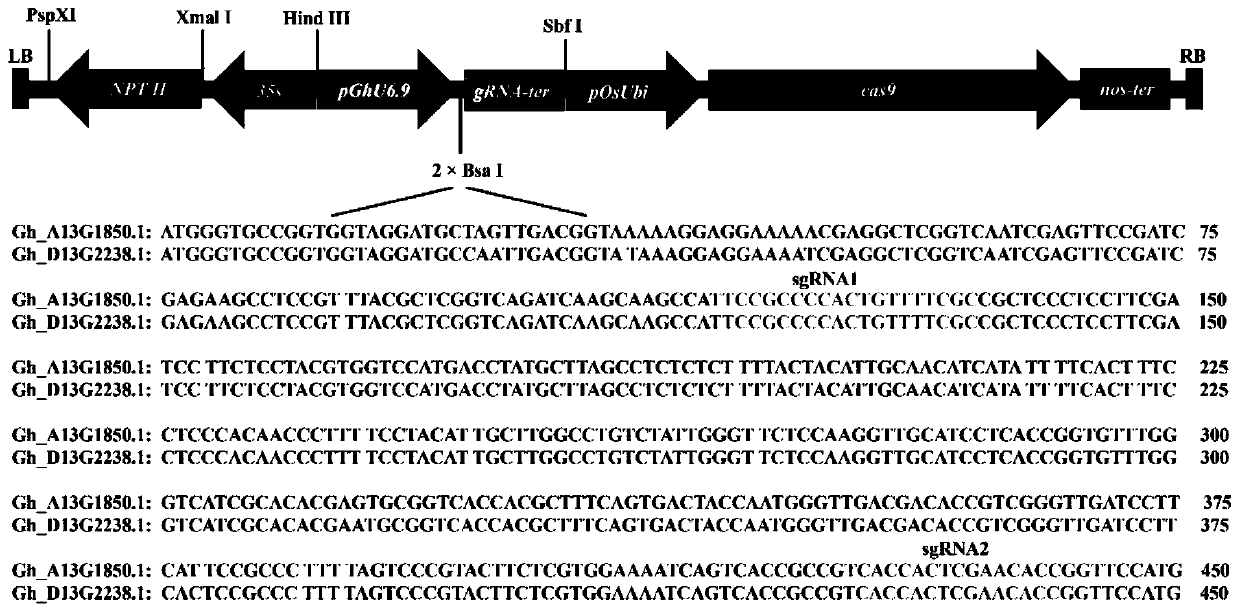Method for obtaining high-oleic-acid cotton by applying gene editing technology
A gene editing, high oleic acid technology, applied in the application, genetic engineering, recombinant DNA technology and other directions, can solve the problems of insufficient genetic stability, incomplete gene silencing, and the oleic acid content of cotton has not yet been seen, so as to reduce linoleic acid. content, the effect of increasing the content of oleic acid
- Summary
- Abstract
- Description
- Claims
- Application Information
AI Technical Summary
Problems solved by technology
Method used
Image
Examples
Embodiment 1
[0025] Example 1: Construction of CRISPR / Cas9 gene editing vector
[0026] 1. gRNA target selection
[0027] Taking the cotton FAD2 gene (Gh_A13G1850 and Gh_D13G2238) as the target gene, using the online software CRISPR-Pv2.0 (http: / / crispr.hzau.edu.cn / CRISPR2 / ) to screen the target, select the target sites sgRNA1 and sgRNA2. The cotton FAD2 gene contains two conserved domains, namely DUF3474 (PF11960) and FA_desaturase (PF00487). The target sgRNA1 is located in the DUF3474 domain, and its PAM sequence is CCA, while the target sgRNA2 is located in the FA_desaturase domain, and its PAM sequence is CCG ;
[0028] The sgRNA1 sequence is: 5'-CCATTCCGCCCCACTGTTTTCGC-3';
[0029] The sgRNA2 sequence is: 5'-CCGTCACCACTCGAACACCGGTT-3'.
[0030]2. Construction of dual-target CRISPR / Cas9 gene editing vector
[0031] Linker primers for sgRNA1 and sgRNA2: According to the designed target sites, synthetically construct vector-related primers, see Table 1:
[0032] Table 1 pRGEB32-GhU6...
Embodiment 2
[0038] Example 2: Obtaining of Gene Edited Cotton Plants
[0039] 1. Preparation of sterile receptor material
[0040] The seeds of the upland cotton variety Huamian No. 1 (HM1) were used as materials, and the seed shells were peeled off after sulfuric acid delinting, sterilized with 70% ethanol solution for 1 minute, and then soaked in 0.1% mercuric chloride (HgCl). 2 ) sterilized for 15 minutes, rinsed with sterile water for 5 times, inoculated on the seed germination medium, and cultured in the dark at 22-28°C for 3-5 days before use.
[0041] The seed germination medium is: 1 / 2MS medium macronutrient + 15g / L glucose + 2.5g / L Phytagel, pH value is 5.8-6.0.
[0042] 2. Cultivation of donor Agrobacterium GV3101
[0043] Agrobacterium tumefaciens GV3101 carrying dual-target sgRNA1 and sgRNA2 was inoculated on LB solid medium plates and cultured in the dark at 28°C for 36-48 hours. Use a sterile toothpick to pick a single colony with good growth, inoculate it into LB liquid ...
Embodiment 3
[0056] Embodiment 3: PCR detection of transgenic cotton plants
[0057] 1. DNA Extraction of Transgenic Cotton Plants
[0058] Using Tiangen Biochemical Technology (Beijing) Co., Ltd. to extract T. 0 DNA from transgenic cotton leaves. Specifically include the following steps:
[0059] (1) Cut 80-100 mg of fresh young leaves of each transgenic cotton plant and wild-type cotton (HM1), and immediately add liquid nitrogen to fully grind, and transfer the ground powder to a numbered 1.5ml centrifuge tube;
[0060] (2) Quickly add 400 μl buffer solution GPS and 10 μl RNase A (10 mg / ml), vortex quickly and mix well, then place the centrifuge tube in a 65°C water bath for 15 minutes, invert the centrifuge tube 5 times during the water bath to better mix the samples ;
[0061] (3) Add 100μl buffer GPA, vortex for 1min, centrifuge at 12000rpm for 5min, transfer the supernatant to the filter column CS (the filter column CS is placed in the collection tube), then centrifuge at 12000rp...
PUM
 Login to View More
Login to View More Abstract
Description
Claims
Application Information
 Login to View More
Login to View More - R&D
- Intellectual Property
- Life Sciences
- Materials
- Tech Scout
- Unparalleled Data Quality
- Higher Quality Content
- 60% Fewer Hallucinations
Browse by: Latest US Patents, China's latest patents, Technical Efficacy Thesaurus, Application Domain, Technology Topic, Popular Technical Reports.
© 2025 PatSnap. All rights reserved.Legal|Privacy policy|Modern Slavery Act Transparency Statement|Sitemap|About US| Contact US: help@patsnap.com



